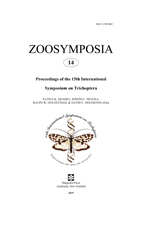Abstract
In field and laboratory experiments, we assessed the role of caddisfly larvae in leaf decomposition occurring in headwaters with a focus on the breakdown of alien Quercus rubra leaves. A field experiment was conducted at two sites: in Wolbórka Spring and 150 m downstream. Eight 0.5 x 0.5 m “mats” were constructed. 1m2 of one type of fallen leaves: Quercus robur, Acer pseudoplatanus, Quercus rubra and Alnus glutinosa was placed in each mat. The caddisfly assemblages on the leaf mats consisted of 550 shredder larvae and 394 predatory larvae of Plectrocnemia conspersa. Among the 4 shredder species in both years, the larvae of P. nigricornis dominated on all leaf species at both sites. In the laboratory experiment, ten Vth instar larvae of Potamophylax nigricornis were placed in to each of four square (30 x 30 cm) boxes containing 500 cm2 of Q. robur, A. pseudoplatanus, Q. rubra and A. glutinosa leaves. The length of time of leaf decomposition was measured in the laboratory. The fastest loss of leaf surface was noted with respect to A. glutinosa (in the field as well as in the laboratory). Shredders collected from Q. rubra mats were numerous and the breakdown rate of leaf litter in the field as well as in the laboratory experiments was similar to Q. robur and A. pseudoplatanus. The number of caddis corresponded with the time of decomposition, which in 2014 was 20 days shorter than in 2013.

